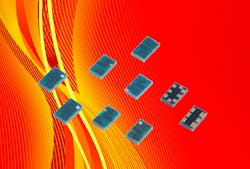Passive components do not often generate the excitement of active devices at technical conferences. Nevertheless, the promise of the new multilayer organic (MLO™) passive circuit technology from AVX Corp. is very real, and is sure to have a significant impact on a wide range of RF/microwave circuits and designs through 20 GHz. The MLO technology has been applied to a number of different “building-block” passive components—including capacitors, inductors, crossovers, and diplexers—with impressive electrical ratings for their miniature sizes.
This file type includes high resolution graphics and schematics when applicable.
The MLO circuit process offers an alternative means of forming passive circuit elements, such as thin-film capacitors, multilayer ceramic capacitors and inductors, and wire-wound inductors. MLO components are based on a combination of low- and high-dielectric-constant printed-circuit-board (PCB) materials (with values of 2.7 to 7.8 in the z-direction at 10 GHz) and low-loss laminates to achieve compact surface-mount circuit elements with stable and reliable electrical performance. These lead-free, RoHS-compliant materials support component structures with extremely fine-line geometries, from 10 to 75 μm, for excellent high-frequency performance. The materials enable the fabrication of very low-profile MLO components compared to, say, low-temperature-cofired-circuit (LTCC) inductors or capacitors for high-frequency applications.
The MLO process, for example, has been used to produce 0402-sized surface-mount inductors with values ranging from 1 to 32 nH and minimum quality factors (Qs) of 17 at a test frequency of 450 MHz. The MLO inductors can be fabricated with extremely tight tolerances, within ±0.05 nH, and with self-resonant frequencies (SRFs) exceeding 20 GHz. They are tolerant of electrostatic-discharge (ESD) pulses to 15 kV and exhibit a coefficient of thermal expansion (CTE) that is closely matched to many popular PCB materials for high reliability over wide temperature ranges. The inductors, rated for current to 875 mA, feature an operating temperature range of -55 to +125°C.
MLO capacitors have been fabricated in 0603 size with ratings of 50, 250, and 500 V. Formed with a thick copper electrode system and direct laser imaging for form circuit features, these capacitors boast consistent Q across frequency for capacitance values to 5.1 pF. As with the other MLO components, they are expansion-matched to many popular PCB materials for consistent dimensional changes over wide operating temperature ranges.
A truly space-saving component made possible with the MLO process is the firm’s diplexers. These are designed with land-grid-array (LGA) terminations and are claimed to be the thinnest 0805 diplexers in the industry, with height of less than 0.5 mm. Available in 0603 and 0805 surface-mount packages, the MLO diplexers (see figure) are designed for use with different wireless communications standards, including cellular and wireless local area networks (WLANs). This allows, for example, two wireless transceivers to operate on a single antenna.
The lead-free, halogen-free diplexers are rated for power levels to 4.5 W and operating temperatures from -40 to +85°C. As an example, model DPO3A2450TTR is a combination lowpass filter (LPF) and bandpass filter (BPF) with center frequencies of 2450 and 5425 MHz. It is specified for maximum insertion loss of 0.40 dB from 2400 to 2496 MHz (with typical performance of 0.35 dB) and maximum insertion loss of 0.85 dB (and typically 0.80 dB) from 4900 to 5950 MHz. The diplexer exhibits typical VSWR of 1.50:1 from 2400 to 2500 MHz and 1.30:1 from 4900 to 5950 MHz, with maximum VSWR of 2.0:1 specified for both bands. As with the other available diplexers, these units are 100% visually inspected and 100% electrically tested. AVX also plans to release a series of 0402 diplexers that will also support WLAN and GPS applications.
AVX’s MLO components offer the opportunity to achieve stable and reliable passive circuit values in low-profile surface-mount structures that can save circuit space compared to other passive component technologies, such as LTCC components. The MLO technology provides electrical benefits, such as lower insertion loss than LTCC components and CTE behavior that is closely matched to that of popular PCB materials to ensure high reliability over wide operating temperature ranges. To assist customers with special needs, the firm draws from an extensive library of device models—including inductors, capacitors, resistors, filters, diplexers, couplers, and baluns—from 700 MHz to 6 GHz, that can be applied to the MLO process to fabricate passive components with relatively quick turnaround times.
AVX Corp., a Kyocera Group Co., One AVX Blvd., Fountain Inn, SC 29644-9039; (864) 967-2150.
This file type includes high resolution graphics and schematics when applicable.
About the Author
Jack Browne
Technical Contributor
Jack Browne, Technical Contributor, has worked in technical publishing for over 30 years. He managed the content and production of three technical journals while at the American Institute of Physics, including Medical Physics and the Journal of Vacuum Science & Technology. He has been a Publisher and Editor for Penton Media, started the firm’s Wireless Symposium & Exhibition trade show in 1993, and currently serves as Technical Contributor for that company's Microwaves & RF magazine. Browne, who holds a BS in Mathematics from City College of New York and BA degrees in English and Philosophy from Fordham University, is a member of the IEEE.

